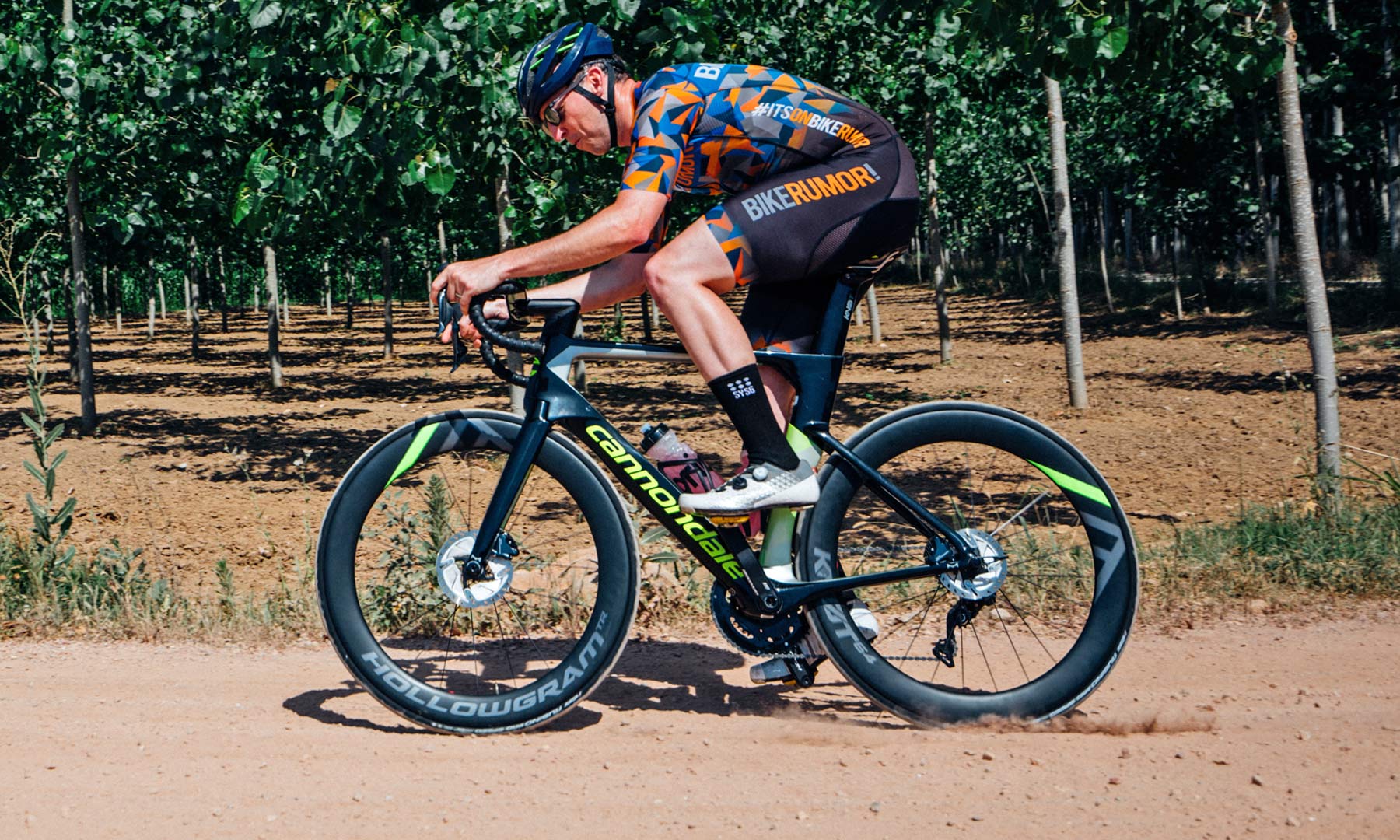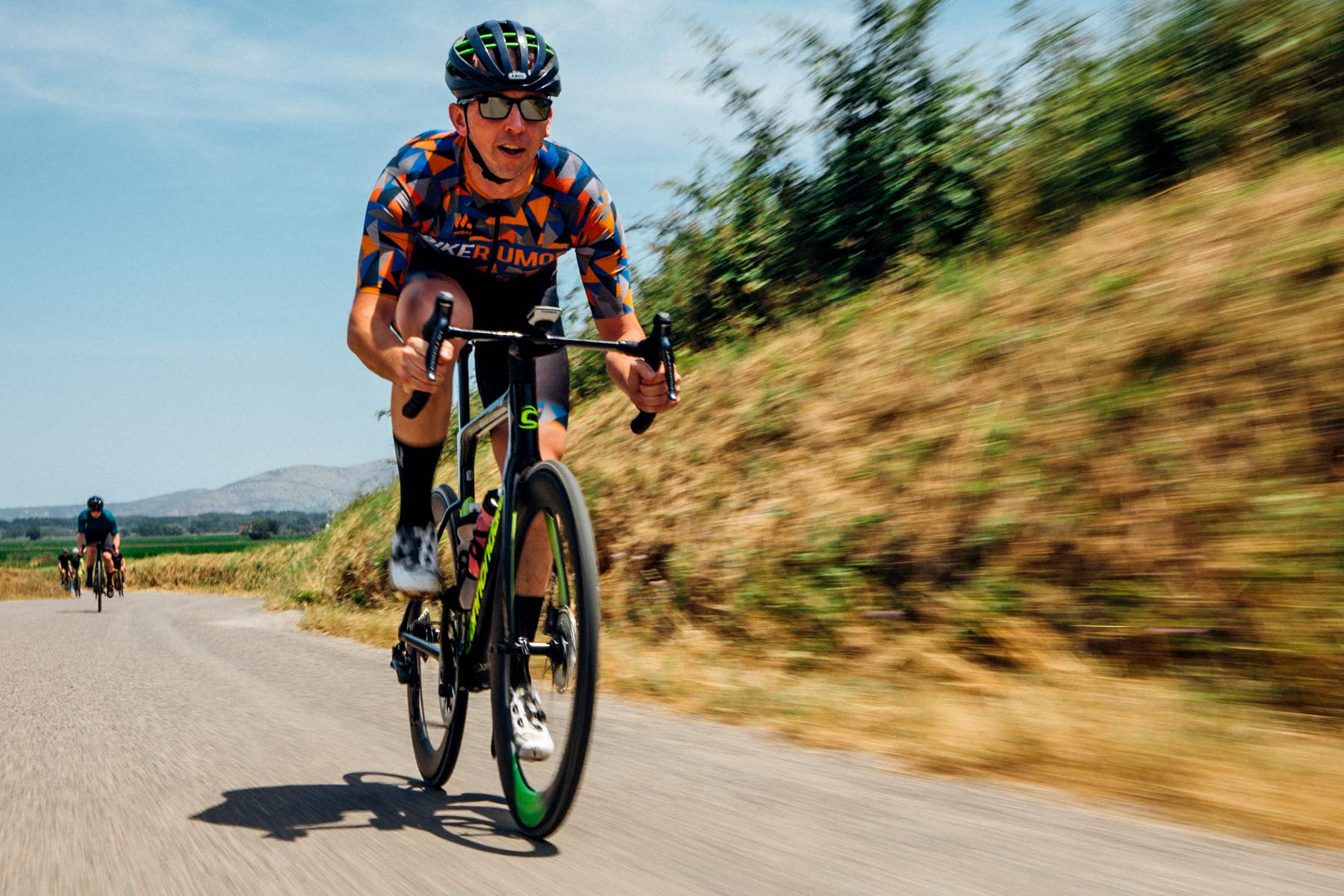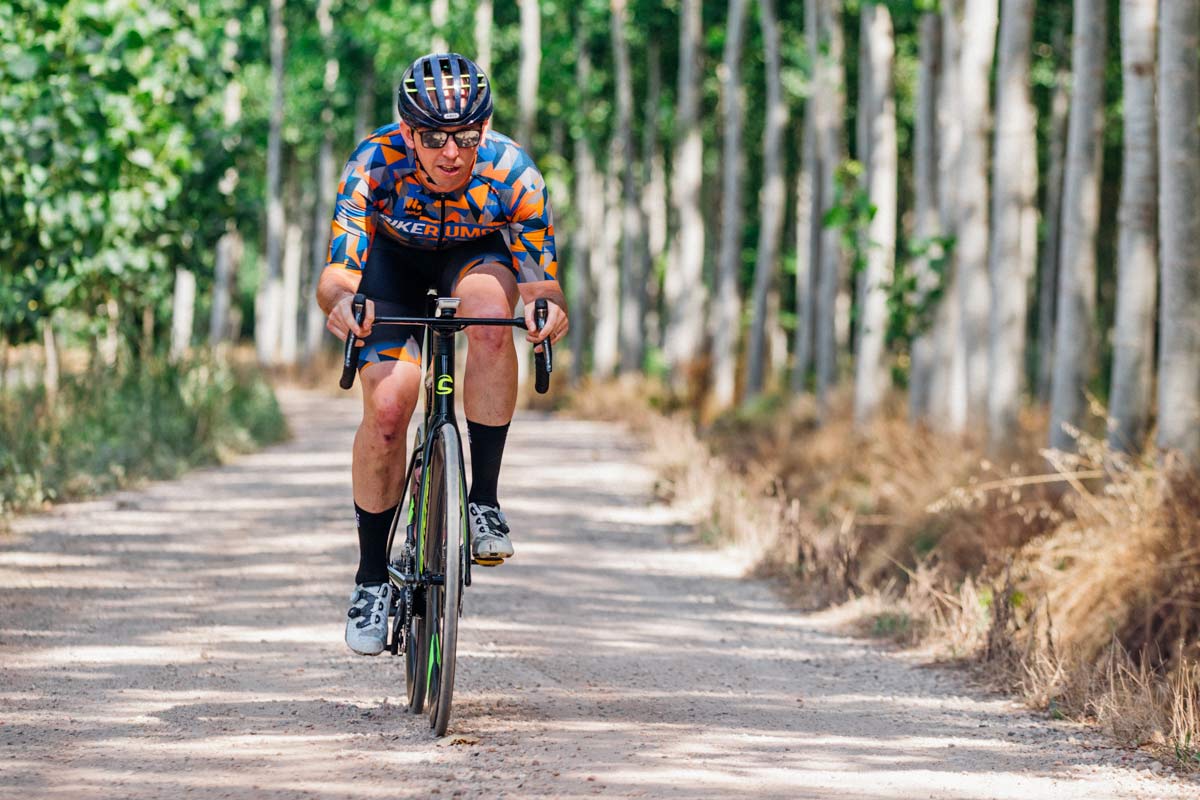We spent a couple of days in Girona last week riding the new aero road bike from Cannondale on new & familiar rolling roads. While not a mountain climber, then new race-focused road bike was designed to be fast not just on the flats, but into the hills as well. Based off a new concept Cannondale’s chief aero engineer dubbed Yaw Weighted Drag, the bike is built for a more average range of wind conditions that we regularly encounter out on the road – designed to be “faster everywhere”. We took that to heart, and even snuck in some gravel road riding on the SystemSix’s 26mm tires.
Cannondale SystemSix carbon disc brake aero road bike
Cannondale recoiled every time we called their new SystemSix an aero road bike. Part of that may be in their coming late to the aero road party, but a lot does seem to stem from this being one of the more versatile aero bikes we’ve thrown a leg over. But there is no mistaking the aero profile this bike strikes. Said to be one of the first to take advantage of the UCI’s more relaxed technical specs – disc brakes are officially legal now! and the 3:1 rule has been for the most part nixed – the new SystemSix is decidedly aero looking.
On the open road the SystemSix has that fast and aero feeling too. While wheels (and good bearings) play a large part in how fast a bike feels riding, the entire SystemSix setup with its uniquely wide, aero Knot64 wheels and Knot SystemBar ticks all the boxes, so…
Is it the Fastest Road Bike in the World?
Well, the SystemSix is fast. But that doesn’t give you an advantage when you are riding with a group of your buddies all on the same bike. Oops. Ok well, I guess it did boost our average speed without having to put in any extra effort. That’s what we are all hoping for, right?
Now looking at average ride speed, the SystemSix did not magically take me from a 30kph average up to 35kph. In fact, I felt quick riding the bike around for a couple of days in a mix of large & small group riding and riding solo, but neither my max or average speeds were significantly higher than normal. While I had ridden some of the same roads before, my routes overall were new to me, so it wasn’t really possible in this short time riding the new SystemSix to reliably evaluate how much faster than other aero bikes were.
But did it make me faster?
If I couldn’t measure how fast I am against a bunch of people on the same bike or against some other bikes I’ve ridden, I realized that I could gauge a bit how much of an equalizer the new SystemSix is, benchmarked against a cohort of other journalists that I encounter on test rides like these regularly. In this grouping, I usually get up the hills a bit slower (I’ll blame that on my 80kg weight) and descend much quicker than the average group (my mass helps, but I’m also a more technical descender).
The interesting things is, with the new SystemSix I didn’t really drop off except on the steepest climbs over 10%, so I felt faster up the average grade climbs. But unfortunately, it seems my downhill prowess was neutralized. The bike was fast for everyone going down, and the other guys used that to their advantage, more able to stick on my wheel.
Review: In the details
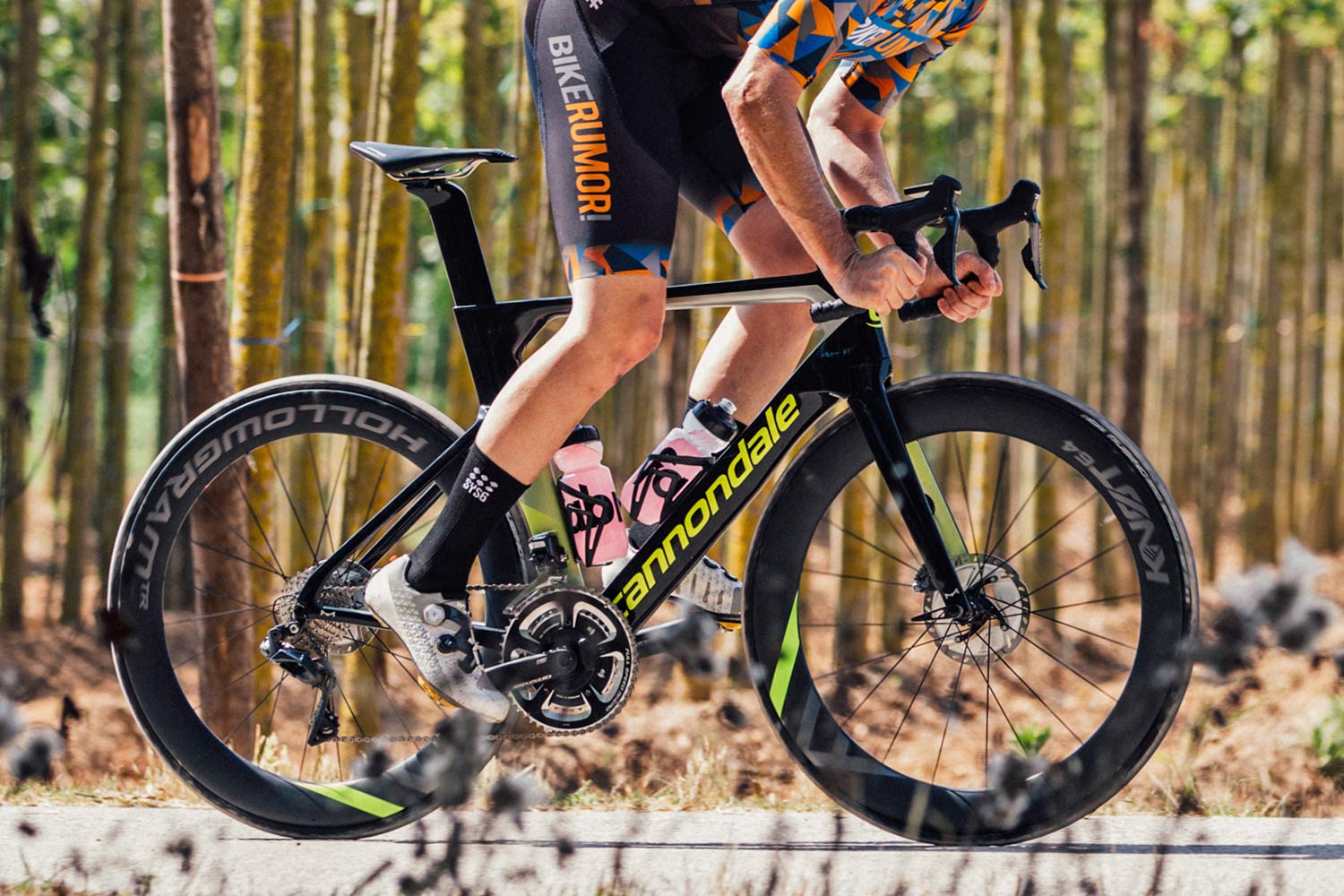 No doubt many of the best characteristics of the overall bike are the result of Cannondale’s System Integration approach. Luckily that for the most part doesn’t make the bike proprietary (outside of the seatpost) or less adjustable, but it all benefits from the wheel+tire and bar+stem combos. To make it clear where Cannondale sees component integration and aero optimization as most important – those components all get named Knot, and labeled as such.
No doubt many of the best characteristics of the overall bike are the result of Cannondale’s System Integration approach. Luckily that for the most part doesn’t make the bike proprietary (outside of the seatpost) or less adjustable, but it all benefits from the wheel+tire and bar+stem combos. To make it clear where Cannondale sees component integration and aero optimization as most important – those components all get named Knot, and labeled as such.
 The tubeless-ready Hollogram TR Knot64 carbon wheels are the biggest component of that, and one of the more unique. With a 32mm wide outside rim profile, you are unlikely to find a wider aero road bike wheelset. Combined with their 21mm internal profile, they have the added benefit of turning 23c tires into 26mm wide or 25c tires into 28mm wide. That’s great as they give you more tire volume without extra weight, but we’d be more interested to see what tire makers think about stretching their skinny tires out that far and changing their designed shape (especially as we’ve had tenuous discussions before with tire makers about using tires on rims wider than the ETRTO spec.)
The tubeless-ready Hollogram TR Knot64 carbon wheels are the biggest component of that, and one of the more unique. With a 32mm wide outside rim profile, you are unlikely to find a wider aero road bike wheelset. Combined with their 21mm internal profile, they have the added benefit of turning 23c tires into 26mm wide or 25c tires into 28mm wide. That’s great as they give you more tire volume without extra weight, but we’d be more interested to see what tire makers think about stretching their skinny tires out that far and changing their designed shape (especially as we’ve had tenuous discussions before with tire makers about using tires on rims wider than the ETRTO spec.)
The question mark left on these wheels, is how they will survive long-term in the real world. I ride a lot of rough roads where irregular cobblestones, storm drain grates, potholes & even cut grooves in the tarmac exist. I even warily encountered similar obstacles on my test rides. With that much of the rim unprotected by the tire from impacts, inevitably these carbon rims are going to hit some hard edges. How they will survive scrapes and scratches is beyond me.
 Furthering the Cannondale Si is the Knot SystemBar. Cannondale was trying to avoid the topic that the same thing was introduced last summer on the endurance Synapse, which never really came to fruition due to manufacturing issues. But the idea is great, and it seems the engineering is now sound.
Furthering the Cannondale Si is the Knot SystemBar. Cannondale was trying to avoid the topic that the same thing was introduced last summer on the endurance Synapse, which never really came to fruition due to manufacturing issues. But the idea is great, and it seems the engineering is now sound.
You get all of the aerodynamic benefits of a one-piece road bar, plus the length, width & angle adjustability of a traditional separate bar and stem setup. Plus you get carbon bar feel, combined with ally stem reliability. The Knot SystemBar even includes nicely managed (actually serviceable!) internal cable routing, and a sleek transition with integrated steerer tube spacers.
 It is an aero bike, so of course it has a hidden wedge-style seatpost clamp. That’s still something that bugs me, but at least the SystemSix’s angled design makes it easy to get at with a regular torque wrench. And something more compact like a preset torque key or even (gasp!) a standard mini multi-tool will work in a pinch as well.
It is an aero bike, so of course it has a hidden wedge-style seatpost clamp. That’s still something that bugs me, but at least the SystemSix’s angled design makes it easy to get at with a regular torque wrench. And something more compact like a preset torque key or even (gasp!) a standard mini multi-tool will work in a pinch as well.
As for the Knot seatpost head itself, it pairs a top-access bolt in the front, with a bottom accessed bolt in the rear. That’s pretty common on deep aero posts. It works well with a saddle with a big cutout like Cannondale specs. But even though it is a one time setup issue for the most part, I wouldn’t look forward to mounting my standard go-to Arione on this bike.
 The tubing shapes of front of the bike are all decidedly deep and aero, but thankfully the rear end of the bike is quite different. Again taking some inspiration from the comfortable endurance rear end of the Synapse, the SystemSix is surprisingly comfortable for an aero bike. It made me (k)not even mind the deep aero seatpost.
The tubing shapes of front of the bike are all decidedly deep and aero, but thankfully the rear end of the bike is quite different. Again taking some inspiration from the comfortable endurance rear end of the Synapse, the SystemSix is surprisingly comfortable for an aero bike. It made me (k)not even mind the deep aero seatpost.
The roads around Girona are not exceptionally smooth. While the open stretches seem well maintained, every town and village you ride through seems to compete for who has the roughest traffic calming devices, and I spent plenty of time on rougher back & farm roads, plus the occasional gravel stretch. And the SystemSix delivered a new aero bike feeling for me – the first time after spending several hours in the saddle of an aero bike where no part of my shoulders, neck, arms, or back were in any way sore. Yeah, comfort!
Oh, one more thing – look at that big QR thru-axle lever. You can see it in the front wheel photo above. Part of the Speed Release system to convince the racers to buy into the bike are those big levers. Unfortunately they can’t be really tucked away much. It is something small, but they kinda bug me.
 The internal cable routing in the front of the headtube and fork is a little scary looking at first glance, leaving the front of the bike rather open. But in reality, doing it this way makes for clean hydro & Di2 routing that is actually easy to reach and said to be simple to route. (Just watch your fingers.)
The internal cable routing in the front of the headtube and fork is a little scary looking at first glance, leaving the front of the bike rather open. But in reality, doing it this way makes for clean hydro & Di2 routing that is actually easy to reach and said to be simple to route. (Just watch your fingers.)
To make it all work is the 50° limited angle stop fork/headset rotation. That will take some getting used to. Out riding on the road it is not at all an issue, as you won’t turn your bar very far unless you are doing some wicked, out of control power slides. But several times while stopped, it annoyed me. Roadside while waiting for the group it limited my track standing skills. And then again while trying to navigate a sandy, dirt village park at super slow speed when I didn’t want to put my Speedplay-equipped foot down, I ended up getting in some creative side & bunny hops to get around. Give me two weeks to get used to it and I would be fine. Until then, it feels weird (just like it does on the Canyon Lux mountain bike.)
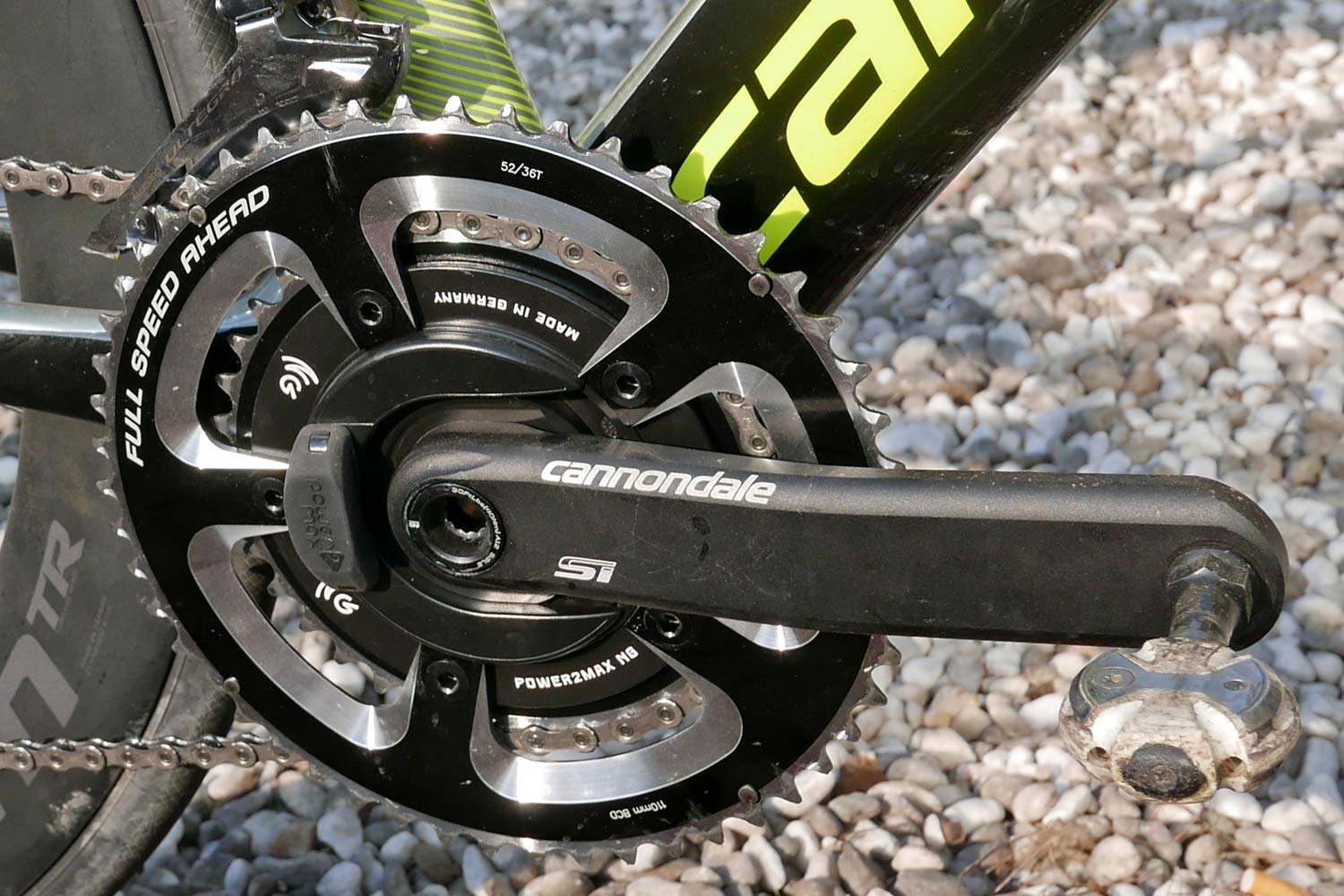 Power meters are cool, everyone should have (access to) a powermeter!
Power meters are cool, everyone should have (access to) a powermeter!
OK, that’s a bit overstated, but it is nice that the option for tracking power is becoming more accessible. Credit to Cannondale for getting power meter hardware onto a bike for no extra money. But it still feels weird to me that you need to send another $500€ direct to Power2Max for them to wirelessly turn it on for you over Bluetooth.
The first bike I hopped on with Cannondale had not had its power meter activated, so when I paired it to my GPS I got cadence data only – better than nothing, right? Someone had paid the 500 bucks on the next one, so I was rolling with power. I’m not training with this bike, so it is collecting a lot of data that I’m not really taking advantage, but when I decide to, having that relatively affordable power measurement on tap is a bonus.
I know someone out there is going to figure out how to hack this thing to turn it on. I just wonder if that will be a good thing – more power to them (unintentional pun notwithstanding) – or bad – as it might stop this type of delivery method?
Final Riding Impressions
The biggest two issue keeping me off an aero bike as my everyday bike have been comfort and space for big tires. Disc brakes have been a boon for tire clearance, and number of modern aero bikes can fit 28+mm tires. Cannondale says the SystemSix can fit wider than 30mm tires with still something like 4mm of space around the tires. But most aero bikes are still uncomfortably stiff. The rear end of the SystemSix is notably more comfortable, and with me running some slightly wider tires set up tubeless (the tubeless Knot64 wheels ship with non-tubeless Vittoria tires, thought to be slightly more aero) this could really be an everyday road bike. I guess that’s why Cannondale kept cringing every time someone called it an aero bike.
There’s no denying that I am still a little hesitant about riding those 32mm wide aero carbon wheels on gravel roads. And as you can see again above, I just can’t resist leaving the asphalt wherever I spot a nice dirt or gravel alternative.
